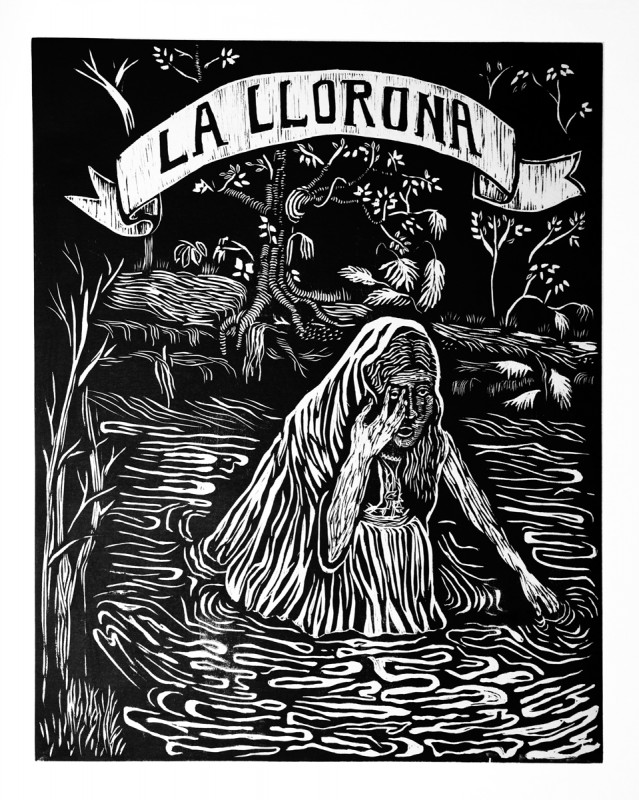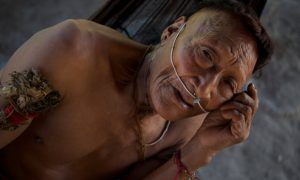There she is, hair black as night with a dress on as white as snow, but for some reason you can’t get a good view of her face. Then, all of sudden, she’s in yours, screaming at the top of her lungs. This is not your typical girl, and although she may sound like one, she is much worse. What you just witnessed is a mother grieving for her children. Some might question her parental instincts, but she only killed them for love, and let’s be honest, love makes you do some crazy things. If you are wondering who I am talking about, the woman I am referring to is La Llorona, who also answers to the name weeping woman.
The story is about a beautiful lady who fell in love with a man. They got married and had children, but sadly the husband died and left the lady to raise their children alone. Even with the struggles of raising her children alone, she found love again with another man. Everything was going great between them, until he found out that she has children. Furious with her, he left her for another woman. Anger and despair filled her heart and her mind, so she blamed her children for ruining what she wanted the most. She believed that if she could get rid of the children, he would come back to her. So she took her children to the river, where she drowned them. But shortly after she realized what she had done, she became horrified at herself. With a broken heart, forever after she then went on in life, mourning for the loss of her children. After her death, it is said that she lures people away to kill them in the hope of finding her lost children.1

This story dates back for centuries, starting before the Spanish Conquest. During that time period, the story is that an Aztec emperor had heard a woman’s cries and asked a nearby priest what it meant. The priest replied, saying that the cries were from the goddess Cihuacoatl, and her cries were one of the eight omens of doom. These omens began manifesting during the ten years before the arrival of Cortes in 1519. Cihuacoatl is the Aztec goddess who supposedly steals children away from their mothers and fathers, then later on sacrifices them.2
In other related stories of La Llorona, the woman isn’t known as La Llorona, but rather as La Malinche, the Indian mistress of Cortes. In this version, she doesn’t weep because of the loss of her children, but instead weeps because she betrayed her people to the conquerors.3 Cortes was the Spanish conquistador and Malinche was sold to him as a slave, but over time she was willing to help him on several adventures, but by doing this, she turned against her people. Although no known children were killed, she does appear to have had children with Cortes. This is where the origins of the legend gets confused on which culture actually created La Llorona. There are rumors saying that the Spanish may have gotten the origins confused with one of their own native legends.4 Regardless of where the story was first heard, the documentation of La Llorona appeared around 1550.5 Over time, the myth of La Llorona has been adapted to different customs and traditions, but each adaptation continues to recount five stable elements: a woman, a white dress, weeping for lost children, wandering, and water.
In other versions of the story, Llorona is simply a woman who drowns her children. English-language versions of the story simply call the woman the weeping woman, with her white dress symbolizing her link to the spiritual world as a ghost. In most of her stories, children do die; therefore, she weeps for them regardless of how they may die. While wandering and water are separate story elements, they go hand in hand in each adaptation. The Weeping Woman will always be wandering to find her drowned children, no matter where the story is told. This is why parents in the American south-west ( in California, Arizona, Colorado, Texas, and Mexico) warn children not to stray away, be naughty, or go out after dark, because they believe if the Weeping Woman is out there wandering, she could find you.6 Not only does she wander everywhere, but she typically will wander near bodies of water. This creates yet another warning that parents impart to their children, believing that water is dangerous and unpredictable. To prevent children from going near water without an adult, they tell their children the tale of La Llorona.
But it’s not just children that she goes after, but rather everyone. Typically, it’s more common for her to go after men than women, because it was a man who drove her to kill in the first place. So she uses her broken heart to get revenge on men because of how betrayed she feels.7 She uses her weeping to lure men to her, then kills them shortly afterwards. Since it is more common for males to be lured away, there are lessons for boys, namely, that the tale suggests to boys that women are temptresses of malevolent sexuality that can cause them to lose their souls as well as control of their bodies.8 While women aren’t primarily targeted, La Llorona can also teach young girls lessons as well, namely, that girls should be careful not to fall for a young man who may have wealth and nice clothes, but who is too far above them to consider marriage.9 Although it may seem unfair to women, overall the tale is meant to protect young ones from disobedience and to guide them in proper behavior. Since the story revolves around a woman, it is common for mothers and grandmothers to tell the Weeping Woman tale. Since the story is more typically shared by women rather than men, women used this to create an adaption in La Lloronas tale. Most females believe that La Llorona is a fragile woman, giving the impression that females are victims. So by evolving her story, they can adapt La Llorona to seem strong and powerful.

In Seguin, Texas you will find a place called Woman Hollering Creek, which crosses Interstate 10 near San Antonio, Texas. It is here where the story changes from one depicting a grieving mother to a survivor. In this version, the woman is a young bride in a white dress. But instead of being left behind by a man, she is beaten and has a miscarriage. The creek goes along her house, so she wanders along it while her husband is away at work. Later on in her life she gives birth, and it was at that point where she conjures up images of La Llorona.10 In this version, it still manages to have all the key elements of La Lloronas story. The white dress because she is a female bride, the weeping for children because she had a miscarriage, the Woman Hollering Creek being her source of water while wandering around it. However, instead of weeping and longing for children for eternity, she uses her voice in other ways. The Woman Hollering Creek story has her gaining her voice as a sign of rejection from domestic abuse. Although it may be completely different from most known stories, this one has became popular in the female world. With La Lloronas’ legend, women experience a sense of feeling trapped because of their lack of control. But in the Woman Hollering Creek version, instead of luring people to their death or seeking vengeance for a violent husband, the woman simply lives her life. She doesn’t cave in to a dangerous mind, but rather show that she’s stronger than that.
Adaptations of these stories will continue to change over time, sometimes making her a victim, sometimes a murderer, and sometimes a survivor. La Llorona may be an old myth, but her lessons and her stories continue. Keep this in mind the next time you misbehave, or wander alone, or go near water, because you never know when you might stumble upon a beautiful lady searching for lost children.
- Celebrating Latino Folklore: An Encyclopedia of Cultural Traditions, 2012, s.v. “La Llorona (The Wailing Woman),” by Leigh Johnson, 657. ↵
- Ana Maria Carbonell, “From Llorona to Gritona: Coatlicue in Feminist Tales by Viramontes and Cisneros,” MELUS 24, no. 2 (1999): 55. ↵
- Betty Leddy, “La Llorona Again,” Western Folklore 9, no. 4 (1950): 365. ↵
- Celebrating Latino Folklore: An Encyclopedia of Cultural Traditions, 2012, s.v. “La Llorona (The Wailing Woman),” by Leigh Johnson. ↵
- Celebrating Latino Folklore: An Encyclopedia of Cultural Traditions, 2012, s.v. “La Llorona (The Wailing Woman),” by Leigh Johnson. ↵
- Bacil F. Kirtley, “‘La Llorona’ and Related Themes,” Western Folklore 19, no. 3 (1960): 155. ↵
- Bacil F. Kirtley, “‘La Llorona’ and Related Themes,” Western Folklore 19, no. 3 (1960): 156. ↵
- Celebrating Latino Folklore: An Encyclopedia of Cultural Traditions, 2012, s.v. “La Llorona (The Wailing Woman),” by Leigh Johnson. ↵
- Celebrating Latino Folklore: An Encyclopedia of Cultural Traditions, 2012, s.v. “La Llorona (The Wailing Woman),” by Leigh Johnson. ↵
- Celebrating Latino Folklore: An Encyclopedia of Cultural Traditions, 2012, s.v. “La Llorona (The Wailing Woman),” by Leigh Johnson. ↵



131 comments
Edith De Loera
Growing up, I was often threatened with La Llorona. I have heard the simple “woman drowns her children and regrets it” version while growing up. I had never been told the story in such great detail, though. I had not the slightest idea that there was so much history behind it! Especially of its descent being from the Aztecs. I am amazed of all the different versions of it, and how they all sort of translate to the same story. La Llorona is an old folk’s tale that I will definitely threaten my children with as well.
Dayna Valdez
I really enjoyed the introduction that you gave. It was a great way to get people interested. I also really enjoyed the featured image you used as well. I’ve always heard of La Llorona and stories behind her and how she came to be. However, your article gave me a better and more clear understanding. Overall, I loved it!
Jasmine Martinez
I really enjoyed this article! As a young child I would hear the story about La Llorona and how she got her name, I was always scared even now hearing about it. The article also provided some interesting information about the many other versions of this story. But it was nice to know about the other stories and the different historical facts included in them.
Alejandra Mendez
This was a very well written and interesting article due to the many versions of La Llorona there are. The different versions of the story brought back many memories of my parents and grandparents telling my sisters and I the story. The most common one I was told was La Llorona being Malinche. But in this version with Malinche, Malinche has children with Hernan Cortes and Cortes eventually leaves Malinche for another woman. Angered at the fact that Cortes left, she felt the children resembled him too much so she decided to drown them. She immediately regretted it and eventually drowned herself looking for her missing children.
Ryann Cervantes
This story is very personal to me because it was always a story told around my community and my family. While I’m not scared anymore it still brought back feelings of creepiness and nostalgia. I found it very interesting reading about the roots of the story and how it’s much older than I had believed. Now I can tell my family more about this story.
Ezequiel De La Fuente
Its so amazing to see how long a story can live on for. I had no clue that the story had so much history behind it. The beginning made me laugh, “This is not your typical girl, and although she may sound like one.” I remember when I was little my grandparents would tell me this story, and I was always afraid to be by lakes at night. Overall I thought this was a well written article. It truly kept me attached and brought back memories.
Alexis Renteria
Very interesting article. Like stated in this article, there are many different ways to tell the story of the Llorona and people don’t know where exactly it came from. Ive heard many different stories about her as well, and even an encounter with her. My cousin claims that when she was in Mexico one summer, she was washing clothes by the river and she heard weeping. She wasn’t too sure what it was at first but when she turned around she saw a woman in a white dress kneeling in the river. I think that hearing stories like these as a kid makes you believe them and maybe even cause you to see them for yourself. Overall, this is a well put together article and it does a great job at telling the various stories and history of the Llorona.
Tara Sellers
When I first read the name La Llorona I realized that I had heard of this story before in the Grimm Tv show. The article explains the legend of La Llorona well and tells us the deeper meanings behind the legend. I find it interesting that there are so many adaptations of this legend and they all have some key element that connects them to one another.
Richard Navarro
There is some crazy love stories from back in the day. All I know is if this lady got in my face and screamed I think I would have punched her. I can’t imagine being in love with someone and them dying, that is one of my biggest fears. I do not think that I can have someone raise my children if it weren’t the biological mother. So maybe I would just let this lady scream at me, hell, I might just hug her
Christine Sackey
I thought that all the different versions of the story were fascinating. I read about the weeping women in a book. I find it interesting that one of the stories has their origins here in San Antonio. The overall story is sad. I can not believe that she drowned her children so that she could win back her lover. It crazy what love can make people do.